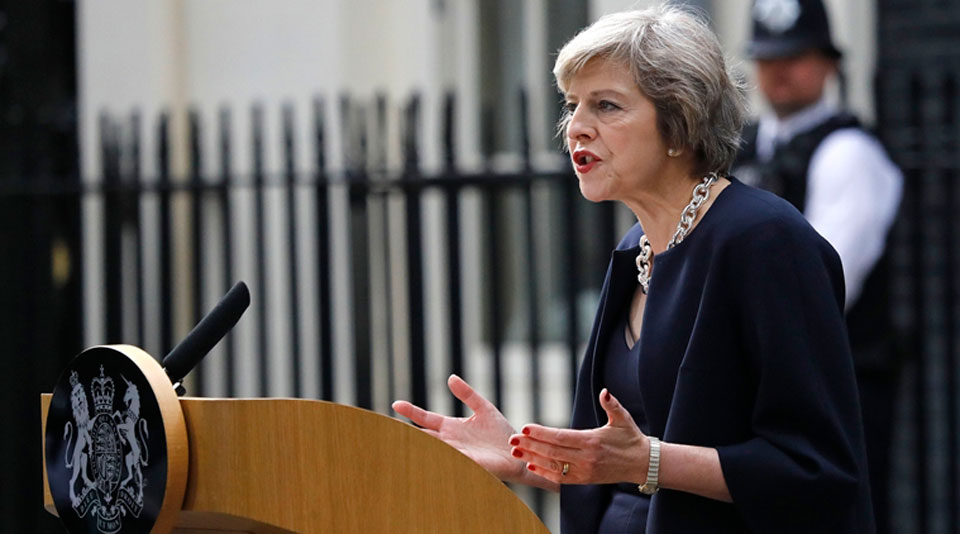
British Prime Minister Theresa May’s proposed European Union (EU) divorce agreement was utterly crushed by Britain’s Parliament last week, with members of Parliament (MPs) rejecting it 432 votes to 202—the largest defeat experienced by a government in modern British political history.
May returned to the House of Commons Monday, January 21 to give a statement on her next steps for Brexit. Her “Plan B” was a slightly watered-down version of last week’s defeated “Plan A,” but did reflect movement regarding two crucial issues—fees for EU citizens in the UK, and a hard border in Ireland—while holding firm on all others.
In her statement, May:
- Refused to rule out a no-deal EU withdrawal, saying the House of Commons must either approve an agreement or revoke Article 50, the measure that called for the UK to leave the EU.
- Said a second referendum would “set a difficult precedent” and “damage social cohesion.
- “committed to ensuring that EU citizens in the UK will be able to stay and continue to access in-country benefits and services on broadly the same terms as now, in both a deal and a no-deal scenario,” by waiving visa application fees.
- “Denied considering reopening the Good Friday Agreement in order to solve the Irish backstop issue.
- Assured MP’s the government would consult with them regularly as negotiations continue, ensuring their voices are heard.
- And said a new motion would be brought up for a vote January 29.
May closed by outlining three key changes needed, including flexibility and openness in engaging Parliament while negotiating future EU relationships, embedding the “strongest possible protections on workers’ rights and the environment,” and a commitment to no hard border in Northern Ireland.
Currently, May is considering putting a “sunset clause” to a vote in Parliament next week, setting a time limit to the Irish border issue, in an effort to secure a divorce agreement that will both win a parliamentary majority and improve negotiations with the EU.
However, EU chief Negotiator Michel Barnier rejected the idea Monday saying the current deal reached with the Prime Minister was “the best deal possible.”
“It’s now for the UK leaders to build this stable and political majority for a deal,” he continued. “We are waiting for the next steps and are ready to work again on the political declaration.”
The House of Commons will also be voting on several amendments proposed by MP’s to the current deal, including an extension of the Article 50 timeline and more parliamentary power to block a no-deal divorce.
The votes will be non-binding but will serve as a test for changes May could consider for her Brexit deal. A binding vote is not expected until February.
In response, Labour leader Jeremy Corbyn submitted a party amendment calling for a parliamentary vote on whether to hold a second referendum.
“Our amendment will allow MPs to vote on options to end this Brexit deadlock and prevent the chaos of a no-deal,” Corbyn said. “It is time for Labour’s alternative plan to take center stage, while keeping all options on the table, including the option of a public vote.”
The amendment—opposed by many Labour frontbench MP’s—is worded to not commit party leadership to backing a referendum if a vote did take place, and called for May’s government to vote on two options: Labour’s alternative Brexit plan, and whether to “to hold a public vote on a deal or a proposition” that is supported by a majority in the Commons.”
Labour’s alternative Brexit plan proposes the UK stay in a post-Brexit customs union with the EU and calls for a strong relationship with the single market.
It is unlikely the amendment will pass.
Here’s a summary of the original Brexit withdrawal agreement:
Citizens Rights:
- UK citizens in the EU, and EU citizens in the UK, will keep their residency and social security rights after Brexit.
- Citizens who relocate to another EU country during the transition period, including the UK, will be allowed to say in the country after the transition.
- Anyone who stays in the same EU country for five years will be able to apply for permanent residence in the UK.
Transition Period:
- The timeline for EU withdrawal begins March 20, 2019 and goes until December 31, 2020.
- The UK will be required to follow all EU rules but will lose membership in its institutions.
- The draft agreement lays out frame work for an extension of the timeline, but only for one to two years—2022 at the latest.
- Any extension must be agreed to by both the UK and EU before July 1, 2020.
Laws and Legal Disputes:
- The UK will remain under jurisdiction of the European Court of Justice (ECJ) during the transition period.
- A joint UK-EU committee will be formed in an effort tot resolve any disputes on interpretation of the agreement.
- If the backstop is triggered and the UK forms a single customs territory with the EU, the ECJ will not be able to resolve disputes between the UK and EU directly.
The Irish backstop:
- If no long-term trade deal is reached by 2020, avoiding a hard border between Northern Ireland and the Republic of Ireland, and no extension to the timeline is reached, then an “If the backstop is triggered and the UK forms a single customs territory with the EU, the ECJ will not be able to resolve disputes between the UK and EU directly.”
- Northern Ireland will have a closer customs relationship with the EU than the rest of the UK—including more alignment with rules and regulations under the EU’s single market.
- The UK won’t be able to leave the backstop independently, it will have to be agreed on with the EU.
Other Provisions:
- Protocols on British military bases in Cyprus.
- UK withdrawal from the European Atomic Energy Community (Euratom)
- Procedures to reach a separate agreement on access to EU fishing in UK waters—primarily Scotland, saying If the backstop is triggered and the UK forms a single customs territory with the EU, the ECJ will not be able to resolve disputes between the UK and EU directly.
The issue of “complete control” over domestic fishing waters, along with the backstop, has led to much resentment from Scottish nationalists, further boosting the calls for Scottish independence.
Other Brexit Options on the Table:
Start over with a “soft” Brexit deal: It would allow Britain to remain part of the EU Bloc’s customs union, or single market, and is likely to receive consideration from EU leaders.
Extend the exit timeline: With the March 29 Brexit deadline fast approaching, Britain could request to extend its departure timeline under Article 50—the legal provision allowing for Withdrawal from the EU—for several months, affording time to renegotiate Brexit’s terms. This option has recently raised concerns in the EU Parliament over how it would affect its upcoming elections.
General Election: The Labour Party has made it clear it will continue to try and force an election and could attempt further no-confidence votes in the upcoming weeks.
Another Referendum: The government could choose to hold another vote on Brexit, but would still require an extension of Article 50, and new legislation would have to be proposed for a referendum to happen, and to determine its rules and who would be allowed to vote. Referendum rules are set up under the “Political Parties, Elections and Referendum Act of 2000.”
No Deal: The UK would leave the EU March 29 as scheduled. The Bank of England has warned an exit with no deal could send Britain into its deepest recession in almost a century, and such a sudden end to trade agreements could gridlock British ports, leading to shortages of food and medicine.
Form a citizen’s assembly: The plan would bring 500 members of the public together, facilitated by experts, that would attempt to reach a consensus on how to move forward. The non-partisan plan was proposed by Labour MP’s Stella Creasy and Lisa Nandy. The citizens assembly was most recently used in Ireland during debates on the countries strict abortion laws
Or, the UK could flat out revoke Article 50 and cancel Brexit: A ruling by the European Court of Justice said the move would be legal and would not need agreement from the other 27 EU countries—quite an unlikely scenario as the government is still committed to Brexit.










